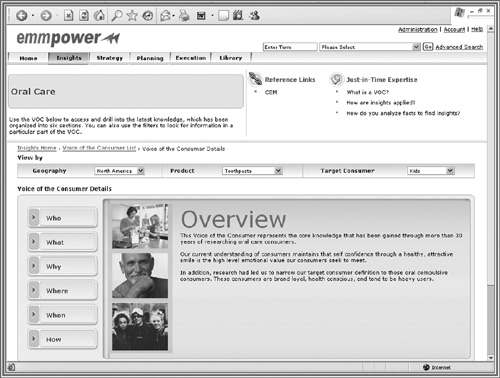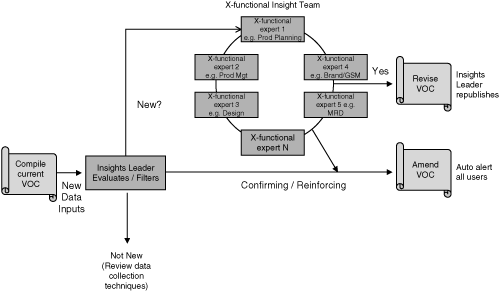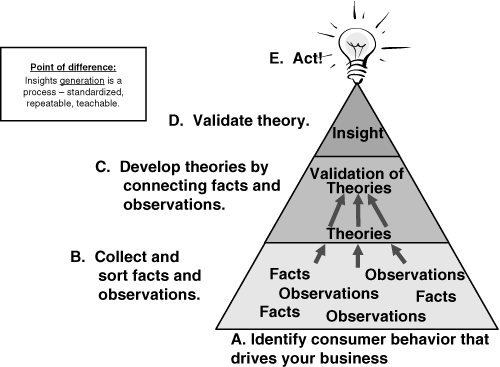Chapter 13. Managing Information
• How does the marketing organization become agile when applying information to real-time decision-making?
• How can the marketing organization increase collaboration and continuous improvement both internally and externally to create value?
• How does technology capitalize on knowledge to increase top-line growth?
• What do you need to do to manage information and knowledge across all business functions?
You need a strategic imperative to make your organization capable of acquiring, processing, communicating, and applying new knowledge so that it can quickly introduce new solutions to customers. If you can accelerate the pace of learning, and the organization can generate new knowledge-processing capabilities as an ongoing activity, this results in capitalization of knowledge. Speed of learning is a sustainable competitive advantage—perhaps the only remaining competitive advantage. Building these processes into the business culture is the challenge of managing information effectively.
In the new paradigm of marketing-led growth, managing knowledge and information is transformed:
Streaming Marketing Information to Be Agile
Traditionally, marketing information has been delivered in a “lumpy” fashion. A research report is issued. It is thick and data-laden, with perhaps a few conclusions, and it is hard to digest and process into knowledge that’s truly useful for the marketer. You are familiar with weekly sales reports or reports about usage and market penetration. These documents have limited utility because they are usually highly delayed and therefore are a lagging indicator of marketing performance. You just cannot respond in real market time.
Information must be timely for management information systems to be useful. It must arrive on a cycle that coincides with its application for a business purpose: use in product design decisions, new marketing communications programs, or decisions about how to provide better customer service.
Today, these decisions are made at a faster pace. Internet services can be developed rapidly and released to the web within weeks or even days. The software development cycle—under a system called agile development—is highly compressed, and feature decisions are often made or reviewed daily. Even such traditional products as cars and detergents require rapid response to marketplace results and changes.
As the pace of marketing development quickens, we need to reengineer the pace of marketing information. Consider it a stream of data that you can tap into at the appropriate moment. You can be confident that it is accurate and useful at that point in time, with continuous change reflecting real-time marketplace developments. So, each time you tap into it, the data reveals what has changed.
We have become accustomed to this real-time information delivery in stock market trading. Now it is available in marketing information systems.
One way to accomplish this is to structure the knowledge base into a series of buckets of predetermined utility. These buckets can then be filled from available information streams. These streams flow at different rates and fill the buckets at different points in time. But whenever a user consults the repository, it is as up to date—as full of the freshest information—as it can be.
The voice of the customer fulfills this example and may include
• Segmentation data
• Usage information
• Attitudinal information
• Ethnography studies
• Qualitative and quantitative survey data
• Customer service data from a call center or website
This data has different periodicity, and it can be arranged into predetermined buckets (see Figure 13.1):
• Who: The customer and potential customer for targeting. This bucket includes segmentation data, demographics, psychographics, population trend data, and any information that can be used for targeting.
• What: Behavior, including what products and services the target customer uses, in our category and adjacent or related categories, and what related behaviors we can observe and measure that are associated with the usage behavior.
• Why: Motivation and the reasons, both functional and emotional, why the customer behaves in the observed manner. The “what” and “why” buckets are the source of insights, the critical fuel cell of the marketing engine.
• Where: Channels and usage locations. Where does the purchase take place, and where does the consumption take place? What other locations or emerging channels might become more relevant in the future?
• When: The usage occasion and every piece of information associated with it. For consumer goods, we can determine if the occasion is solo or with friends and family; is it frequent or occasional? For services, is the usage emergency-based or regular? For business-to-business, when does the usage of the goods or services occur, and how does this affect purchase cycles?
• How: How the customer uses your products and services; how the consumer uses media and how you can reach the customer; and other methodologies of finding, buying, and using that the customer employs.
Figure 13.1. The who-what-why-where-when-how organization of marketing information.

We can construct a website or web-based knowledge service that is prebuilt to provide information in these buckets. We can then link it to information feeds that push the relevant data (that has been meta-tagged and appropriately identified) into the right bucket. Whenever information arrives, it can update the buckets and alert subscribers to any changed information. The information may come from a research study, a sales report, or a continuous web crawl. Analysts may be able to add commentaries and draw conclusions and label these as commentary distinct from the raw information.
Marketing professionals experience the data as a stream. If they are subscribers, a frequent set of alerts arrives in their in-box, announcing new information in one bucket or another. Clicking the link takes the user there. Whenever they are engaged with a software development or marketing communications development activity, they can go to the site for the latest information. This gives them all the knowledge of the field at the point in time they need it. All products and communications are informed with the latest possible information about the customer; therefore, they have the highest inherent marketplace value.
Collaboration and Continuous Improvement
With finite marketing information—produced as point-in-time reports such as sales and distribution by region—there were separate information producers and information consumers. Information producers were specialists such as market researchers, ethnographers, data scientists, and analysts. Information consumers received this data as a handoff. They processed it into knowledge used in marketing and new-product development plans and refinements to existing marketing activities.
These disconnected roles with unrelated data reports are an anachronism. The marketing community, in its drive to turn information and data into a knowledge stream that continuously feeds innovation and better communication, must become more focused on collaboration compared to information producer/consumer handoffs. A good parallel is Wikipedia, the collaborative online encyclopedia. Its organizing principle is that knowledge is the sum total of contributions from a wide range of sources and people. It might not be as formally packaged and organized as the venerable Encyclopaedia Britannica, but the information is more likely to be timely. It also reflects the knowledge management of a community of people with common interests.
The marketing information exchange we propose is not quite as open as Wikipedia. It is a collaboration of all stakeholders in a company’s marketing community—researchers, ethnographers, brand managers, product planners, product developers, field sales, and sales planners. It starts with the who-what-where-when-why-how structure, into which information is streamed from many sources (see Figure 13.2). An individual or a selected group of insights leaders applies a filter to the incoming information stream to ask if this adds to what you already know.
Figure 13.2. Voice of the consumer stream.

If the incoming data offers nothing new, it is rejected. A note is made to review collection techniques because knowledge processing resources are wasted if there is nothing new in the data. If the data is fresh and serves to confirm, reinforce, and update current insights, the knowledge repository (such as the voice of the consumer website) is updated. Also, subscribers are alerted to the new, updated information. If the data is genuinely new and can create new insights, the filtering team tags it and sends it to an expert insight team.
This team is not a panel of elitists handing down their judgment. Rather, it is an ad hoc group of cross-functional experts who have regular jobs in product development or planning or marketing communications. Because they are fully cognizant of current knowledge, they can look at new data and decide whether it offers new insight. They can call an “Insights Workshop” to creatively process the knowledge into a new, distilled insight. They can then publish the new insight and alert the entire community.
The community will then build on it, add to it, polish it, and give it depth and dimension from new perspectives and different geographies—in short, make it better and more useful.
Knowledge is a community asset and a community activity. It gains utility when it is shared and used by all.
Specifically, the benefits of this activity are
• Reducing the time required to achieve goals
• Eliminating redundancies
• Improving the ability to sense and respond to changing markets or service problems and opportunities
Knowledge and Information as Input
Data, Knowledge, Insights, and Innovation
Information and data can be transformed in a continuous stream of knowledge to help birth insights. In turn, insights drive ideas for innovations for new products, new communications campaigns, or new ways to serve the customer with a better experience. These innovations generate revenue growth. So information, in a series of state changes, becomes a revenue asset as an innovation.
Conventional information production is an output. Produce a great report, or a great dashboard, and you’re finished. We propose that information is input to the value creation stream.
The information value stream is illustrated in Figure 13.3. Facts and observations are inputs at the base of a stream that generates ideas or theories to explain the observed customer behavior. The theories that best explain the behavior (or explain nonbehavior and suggest innovations that can change behavior) can be validated through testing. As soon as the validated theory—an insight—is at its highest point of development, it must be linked to action. Action is a new product or some other form of innovation that provides increased perceived value to the customer.
Figure 13.3. How to generate insights.

The Role of Technology in Facilitating the Capitalization of Knowledge
Five processes use technology as a means and method to create knowledge for effective use in building businesses:
• Creation and discovery
• Access
• Speedy transfer
• Sharing
• Utilization
Creation and Discovery of Knowledge
We are all used to “Googling” for things we need to find out about. It’s easy to forget that someone had to create the knowledge base for us to search in the first place. The Internet has lots of individuals and groups dedicated to creating knowledge that the rest of us can search for. It’s one of the inefficiencies of corporations that it is much more difficult to do this inside the corporation, on the intranet rather than the Internet. No one is dedicated to knowledge creation in the corporation. It is necessary to create the corporate knowledge base that all users can contribute to and all can share. This is where technology can help: by creating one set of what the corporation knows. The knowledge base must also be able to absorb and present new data as it enters the corporation in a stream from sales data, user data, web crawls, and other flows.
Access
Often the corporation owns knowledge but users can’t access it. The knowledge workers are denied access to the knowledge that they need to do their job most effectively. So the corporate knowledge base must be accessible to everyone who can use the knowledge to create value. It must be accessible via laptops, handhelds, and mobile phones on demand, using an effective internal search algorithm. When speed of learning is at stake, access is more important than security.
Speedy Transfer
Accelerating the speed of knowledge transfer from the field to product innovation is a winning strategy. Using the techniques of subscription, knowledge push, and linking names and titles to specific information sources, individuals and groups can become immediately aware of new information. In this way, technology can play a role in this transfer of knowledge. But human dynamics have an important role, too. The corporation must celebrate and reward those who transfer information via effective communication.
Sharing
Quantum leaps occur at intercepts of different knowledge bases and technologies. When medicine interacts with information technology in the analysis of the human genome, we can suddenly make incredible progress in solving medical problems.
All of this happens via sharing and connectivity between diverse bodies of knowledge.
The advances in the new marketing come from the same stimulus—the interaction of diverse approaches and disciplines. Marketers interact with scientists who address problems brought to them by market researchers. Chapter 7, “Open Innovation and New Product Development Through Communities of Practice,” illustrates this.
Utilization
All this matters only if the knowledge and insights are used to create value through innovation to better meet customer needs, create better marketing communications, and do better marketing planning. Corporations must measure not the amount of their knowledge but the degree to which it creates growth in revenue streams. The return on information must be calculated. Otherwise, huge waste will occur in purchasing, or paying to collect, information that is never used—information on which there is no economic return.
Summary
• Knowledge management is a high-return investment for the innovative company.
• To match the pace of change, knowledge and information must be streamed rather than arriving in lumps.
• Knowledge must be accessible to all, in one place, representing “one truth.”
• Information sharing is critical to creating value.
• Measure your return on information.

